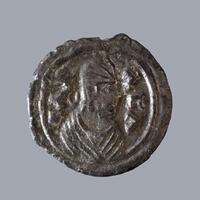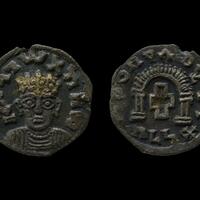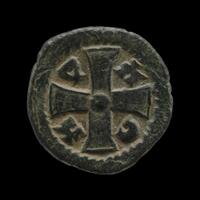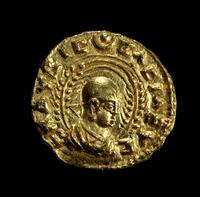Aksumite coins
Type:
Coins
Date:
Third to seventh century
Location or Findspot (Modern-Day Country):
Ethiopia
Description:
The Kingdom of Aksum (modern-day Ethiopia and Eritrea) began to issue its own coins around 270. In the following century, it adopted Christianity as its official religion under King Ezana (fl. ca. 320–60). Aksumite coins followed Roman models in their use of bust portraits, but they soon became the earliest coins to depict images of crosses.
A pre-Christian gold coin of King Endubis, minted ca. 270–300, has the bust of the king on both sides. He wears a headcloth and appears between two wheat stalks. Above the king's head are the symbols of the disc and crescent, which were common to the religions of the Arabian Peninsula.
A fourth-century silver coin with the bust of an unknown king on one side has a cross on the reverse, the new symbol of the king's devotion to the Christian religion.
A fifth-century gold coin has the bust of King Ebana on both sides (one with a crown and the other with a headcloth), each flanked by wheat stalks. Crosses appear as part of the Greek inscriptions identifying the king (parts of this inscription have an unclear meaning). The coins of Ebana, minted around 450–500, are the most common Aksumite gold coins and have been found primarily on the Arabian Peninsula. This coin was discovered in Aden (modern-day Yemen).
A silver coin of Za-ya'abiyo la-Madhen Negus (minted ca. 520–50) shows the king wearing a gilt crown. On the reverse is a cross inlaid with gold under an arch and an inscription in Ge'ez that reads, "The king who exalts the Savior."
On the obverse of another sixth-century coin, this one minted in copper ca. 550–600, King Ioel wears a crown with a cross. The reverse has a large cross with a central boss. The Ge'ez inscription reads "King" on the obverse and "Ioel" on the reverse.
A copper coin of King Armah, minted 600–630, shows the crowned king seated on a high-backed chair or throne. He holds a cross-staff as a symbol of his power. On the reverse is another cross flanked by two wheat stalks and an inscription in Ge'ez that reads, "Let there be joy to the people."
A pre-Christian gold coin of King Endubis, minted ca. 270–300, has the bust of the king on both sides. He wears a headcloth and appears between two wheat stalks. Above the king's head are the symbols of the disc and crescent, which were common to the religions of the Arabian Peninsula.
A fourth-century silver coin with the bust of an unknown king on one side has a cross on the reverse, the new symbol of the king's devotion to the Christian religion.
A fifth-century gold coin has the bust of King Ebana on both sides (one with a crown and the other with a headcloth), each flanked by wheat stalks. Crosses appear as part of the Greek inscriptions identifying the king (parts of this inscription have an unclear meaning). The coins of Ebana, minted around 450–500, are the most common Aksumite gold coins and have been found primarily on the Arabian Peninsula. This coin was discovered in Aden (modern-day Yemen).
A silver coin of Za-ya'abiyo la-Madhen Negus (minted ca. 520–50) shows the king wearing a gilt crown. On the reverse is a cross inlaid with gold under an arch and an inscription in Ge'ez that reads, "The king who exalts the Savior."
On the obverse of another sixth-century coin, this one minted in copper ca. 550–600, King Ioel wears a crown with a cross. The reverse has a large cross with a central boss. The Ge'ez inscription reads "King" on the obverse and "Ioel" on the reverse.
A copper coin of King Armah, minted 600–630, shows the crowned king seated on a high-backed chair or throne. He holds a cross-staff as a symbol of his power. On the reverse is another cross flanked by two wheat stalks and an inscription in Ge'ez that reads, "Let there be joy to the people."
Relevant Textbook Chapter(s):
1,
2,
3
Tags:
East African,
Christian,
Sub-Saharan,
Status and identity,
Coins,
Greek,
Metalwork,
Ge'ez








